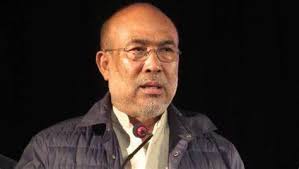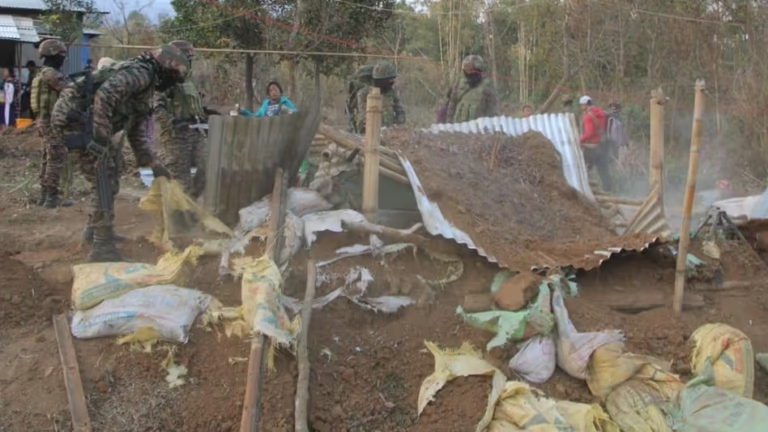Manipur Teenage Boy Shot Dead in Broad Daylight at Moirangkampu, Awang Leikai: A Shocking Incident and Ongoing Probe
Summary
In a heart-wrenching incident that has sent shockwaves through the community, a teenage boy was shot dead in broad daylight at Moirangkampu, Awang Leikai in Manipur. The incident, which occurred under seemingly ordinary conditions, has raised urgent questions about public safety and law enforcement in the region. Authorities have launched an intensive probe to unravel the circumstances behind the tragedy, while the community mourns a young life cut short in an act of violence that remains shrouded in mystery.
In-Depth Article
Introduction
Have you ever felt the chill of disbelief when news of senseless violence strikes your community? Recently, Manipur, a state known for its rich cultural heritage and vibrant communities, was rocked by the tragic death of a teenage boy who was shot dead in broad daylight at Moirangkampu, Awang Leikai. As if plucked from a nightmare, this shocking incident has left residents and authorities grappling with countless questions and a desperate need for answers.
In this article, we’ll take you through a detailed exploration of the events surrounding this tragic loss, dive into the ongoing investigation, and discuss the broader societal implications. Let’s embark on this journey together, peeling back the layers of this heart-stopping event, and trying to understand what it means for the future of safety and justice in Manipur.
Understanding the Incident
On a day that began like any other, the normal rhythm of life in Awang Leikai was abruptly shattered. Eyewitnesses report that the peaceful environment was marred when gunshots rang out in broad daylight, leaving a community in shock. At the center of this tragedy was a teenage boy—a young life filled with promise, now extinguished by an act of violence that no one saw coming.
Reports suggest that the incident took place at Moirangkampu, a locality that, until now, was considered relatively secure. The fact that such a brutal act occurred in broad daylight adds an extra layer of horror. Imagine walking down a familiar street, only to witness an act of violence so sudden and inexplicable that it feels like a scene from a movie. This is the grim reality that the residents of Awang Leikai are now forced to confront.
Location and Context: Moirangkampu, Awang Leikai
Moirangkampu, located in the heart of Awang Leikai, has long been a community where neighbors know one another, and the streets are filled with the everyday bustle of life. It is a place where local traditions, cultural celebrations, and community interactions form the backbone of social life. However, recent events have cast a shadow over this idyllic setting, forcing residents to question the safety of their environment.
The choice of location for such a violent act is particularly unsettling. Broad daylight shootings are not common in areas where community bonds are strong and life is generally predictable. The fact that the teenage boy was shot in such a public setting has intensified public fear and drawn immediate attention from law enforcement agencies and the media alike.
Eyewitness Accounts and Initial Reactions
Eyewitnesses to the incident describe a scene of chaos and disbelief. According to accounts gathered from locals, the sound of gunshots shattered the usual calm of the neighborhood, and within moments, panic and confusion reigned. Some witnesses reported seeing a figure fleeing the scene, while others struggled to comprehend what had just occurred.
One resident recalled, “It was like time stopped for a moment. One moment we were chatting on the street, and the next, we heard these loud shots. We couldn’t believe our eyes when we saw what had happened.” Such personal accounts not only highlight the abruptness of the violence but also serve as a stark reminder that no community is immune to the grip of criminality.
The Victim: A Life Lost Too Soon
At the heart of this tragedy lies the story of a teenage boy whose life was tragically cut short. While details about his identity are being carefully preserved pending investigations, what is clear is that he was a young individual with dreams and aspirations. His untimely death is not merely a statistic—it is a personal loss that echoes through the hearts of his family, friends, and the broader community.
The death of a youth in such violent circumstances raises profound questions about the social and psychological factors that may have contributed to this incident. Were there warning signs that were overlooked? What forces—be they local disputes, gang activities, or political unrest—could have led to such an act? These are questions that the community and investigators are now desperately seeking answers to.
The Investigation: Probe Underway
In the wake of the incident, law enforcement agencies have mobilized quickly to launch a comprehensive investigation. The probe is aimed at uncovering the sequence of events that led to the shooting and identifying those responsible. Early indications suggest that the incident may be linked to broader issues of security and law enforcement challenges in the region.
Authorities are employing a range of investigative techniques, from forensic analysis of the crime scene to gathering eyewitness testimonies. Modern technology, including surveillance footage and digital evidence, is being used to piece together what happened on that fateful day. The investigation is not only focused on finding the culprit but also on understanding the underlying motivations that drove this heinous act.
Imagine a puzzle where every piece is crucial; investigators are methodically gathering these pieces in the hope that a clear picture of the event will emerge. The community, meanwhile, awaits answers, demanding transparency and accountability from those in power.
Community Impact and Societal Implications
The impact of this incident on the local community cannot be overstated. In a region where communal bonds are strong, the loss of a young life in such a violent manner has created a ripple effect of grief and anxiety. Residents now find themselves living with a heightened sense of vulnerability, wondering if such violence could erupt again in their neighborhood.
This incident also forces us to ask critical questions about societal influences. What are the factors that lead to such episodes of violence? Is there an underlying culture of impunity or neglect that allows these acts to occur? And perhaps most importantly, what can be done to ensure that the safety and well-being of every community member are protected?
The social implications extend beyond the immediate tragedy. This event is a stark reminder of the challenges that many communities face across the country—challenges that require concerted efforts from government, law enforcement, and community leaders to address systemic issues such as unemployment, social disenfranchisement, and lack of educational opportunities.
Historical Perspective: Violence in Manipur
Manipur has, over the years, grappled with episodes of violence and unrest. The state’s history is marked by a series of incidents that have challenged its social fabric and tested the resolve of its people. While this incident is particularly shocking due to its occurrence in broad daylight and in a familiar locality, it is not entirely out of character in a region that has seen its share of turbulent events.
Historical incidents in the region have often been driven by complex interplays of political, social, and economic factors. Militancy, insurgency, and communal tensions have all contributed to an environment where violence can erupt suddenly and without warning. This latest tragedy is a grim addition to that legacy, underscoring the ongoing struggle for peace and stability in Manipur.
Potential Motives and Speculations
In the immediate aftermath of such incidents, there is often a flurry of speculation about the possible motives behind the act. While it is important not to jump to conclusions, several factors are being considered by investigators. Could the shooting be linked to personal vendettas, local disputes, or even a broader criminal network operating in the area?
Some experts suggest that incidents like these might be symptomatic of deeper societal issues. For instance, areas facing economic hardship and limited opportunities are sometimes more vulnerable to the lure of criminal elements. Others point to the possibility of inter-community tensions or political motivations as potential catalysts for such violence.
Think of it like a pressure cooker—when various pressures (social, economic, political) build up over time, the slightest trigger can lead to an explosive release. This incident may very well be the result of such accumulated pressures, and only a thorough investigation can reveal the true motives behind it.
Law Enforcement Response and Challenges
The swift response of law enforcement is a crucial element in addressing such violent incidents. In this case, the prompt mobilization of security personnel and the initiation of a detailed probe demonstrate the commitment of the authorities to uphold law and order. However, the challenges they face are multifaceted.
Operating in a region like Manipur, where the terrain, socio-political factors, and historical grievances often complicate security operations, requires not just bravery but also sophisticated strategies. The law enforcement agencies are tasked with not only investigating the incident but also reassuring the public that such violence will not become a recurring nightmare.
Imagine the police as a shield, working tirelessly to protect the community from further harm. Their ability to gather intelligence, coordinate with local leaders, and use modern technology effectively can make all the difference in restoring a sense of normalcy. Nevertheless, the path to ensuring lasting peace is long and fraught with challenges.
The Role of Local Government and Community Leaders
Local government officials and community leaders play a pivotal role in managing the aftermath of such incidents. Their responsibilities extend beyond immediate crisis management; they must work to heal the wounds of the community and prevent future tragedies. In the wake of the shooting, calls for action have intensified, with residents urging local authorities to take concrete steps to improve safety and address the root causes of violence.
Community leaders can serve as bridges between the public and law enforcement, helping to foster dialogue and mutual trust. Initiatives such as neighborhood watch programs, community meetings, and local support groups can be instrumental in building resilience. When the community comes together, it can create an environment where voices are heard, and potential issues are addressed before they escalate into violence.
Psychological Impact on the Youth and the Community
One of the most distressing aspects of this incident is its impact on the psyche of the community, especially its youth. Seeing a peer fall victim to such a brutal act can leave a lasting scar, instilling fear and mistrust among young people. Parents, educators, and community leaders now face the daunting task of reassuring the youth and providing them with a sense of security.
It’s like watching a favorite tree in your neighborhood suddenly uprooted—a loss that leaves an emotional void and raises questions about the future. Programs aimed at mental health support, counseling services, and community engagement initiatives are essential in helping the youth cope with this trauma. By addressing the psychological wounds, the community can begin the slow process of healing and rebuilding trust.
Media’s Role and Public Discourse
In today’s digital age, the role of media in shaping public discourse is more significant than ever. The news of the shooting has not only been reported widely but has also sparked intense debates on social media and other platforms. While media coverage can help bring attention to the incident and the need for improved security, it is also important that such reporting is balanced, factual, and sensitive to the community’s grief.
Responsible journalism is like a double-edged sword—it can inform and empower the public, but if mishandled, it can also fuel panic and misinformation. In this case, media outlets are tasked with presenting the facts, providing context, and giving a voice to the community’s concerns while respecting the privacy and dignity of those affected.
Steps Toward Justice and Accountability
For the community to move forward, it is imperative that justice is served. The ongoing investigation must be thorough, transparent, and free from any external influences. Accountability is not just about punishing the perpetrators but also about restoring faith in the system. Families and community members need to see that their concerns are being taken seriously, and that measures are in place to prevent such tragedies in the future.
Legal experts emphasize that a fair judicial process, supported by strong evidence and competent legal representation, is the cornerstone of lasting justice. This process, although sometimes slow, is necessary to ensure that the rights of the victim and the community are upheld.
The Broader Implications for Manipur’s Future
The tragic shooting of a teenage boy in Moirangkampu is more than just an isolated incident—it is a stark reminder of the vulnerabilities that persist in certain pockets of society. As the community and the authorities grapple with the aftermath, this event serves as a call to action for systemic reforms. Strengthening law enforcement, investing in community development, and addressing socio-economic disparities are all part of a larger strategy to secure a safer future for Manipur.
This incident, while deeply painful, could also serve as a catalyst for positive change. By learning from this tragedy, policymakers and community leaders have the opportunity to implement measures that could prevent similar occurrences in the future. It’s like a wake-up call—one that forces everyone to confront uncomfortable truths and work collectively towards a solution.
The Path Forward: Recommendations and Future Strategies
In light of the recent events, several strategies can be recommended to ensure long-term peace and security in the region:
- Enhanced Community Policing: Strengthening ties between law enforcement and community members through regular outreach programs can build trust and help in early identification of potential threats.
- Youth Engagement Initiatives: Investing in education, vocational training, and recreational activities can provide young people with alternatives to violence and reduce the risk of radicalization.
- Improved Surveillance and Intelligence Gathering: Leveraging technology and modern surveillance tools will enable authorities to monitor high-risk areas more effectively, ensuring prompt responses to any suspicious activities.
- Transparent Investigations: A commitment to a transparent and fair investigation will not only serve justice but also reassure the public that accountability is being maintained.
- Mental Health and Counseling Services: Establishing support systems for those affected by violence can aid in community healing and resilience building.
Conclusion
In conclusion, the tragic shooting of a teenage boy in broad daylight at Moirangkampu, Awang Leikai is a painful reminder of the fragility of life and the urgent need for enhanced security and community support in Manipur. While the ongoing probe is essential to uncover the truth behind this heart-wrenching incident, the broader challenge lies in addressing the underlying issues that foster an environment where such violence can occur.
As residents of Manipur and as members of a larger global community, it is our collective responsibility to ensure that the voices of the victims are heard and that justice prevails. Only through comprehensive measures that include improved law enforcement, community engagement, and social reforms can we hope to create a future where incidents like this become a distant memory rather than a recurring nightmare.
Let this tragedy be a catalyst for change—a moment when the community and its leaders come together to build a safer, more secure environment where every young life is cherished and protected. In the end, the strength of a society is measured not by the challenges it faces, but by how it rises above them, united in its resolve to create a better tomorrow.
Frequently Asked Questions (FAQs)
- What are the known details of the incident at Moirangkampu, Awang Leikai?
The incident involved the shooting of a teenage boy in broad daylight, an event that has left the community in shock. Eyewitnesses reported hearing gunshots and witnessing chaos, prompting an immediate and ongoing police investigation. - How are the authorities responding to this tragedy?
Law enforcement agencies have launched a detailed probe to determine the circumstances surrounding the shooting. They are collecting eyewitness testimonies, analyzing forensic evidence, and employing modern surveillance techniques to uncover the truth. - What impact has this incident had on the local community?
The shooting has deeply affected the community, instilling fear and grief. Residents are demanding enhanced security measures, greater transparency in the investigation, and long-term solutions to prevent future violence. - What steps are being recommended to improve safety in the region?
Experts suggest enhanced community policing, improved intelligence gathering, youth engagement initiatives, and the establishment of mental health support services to build resilience and prevent further incidents. - How can this tragedy serve as a catalyst for positive change in Manipur?
By addressing the underlying social, economic, and security issues that contributed to the incident, community leaders and policymakers can work together to implement lasting reforms. This collaborative effort could help restore public trust and create a safer environment for all residents.



